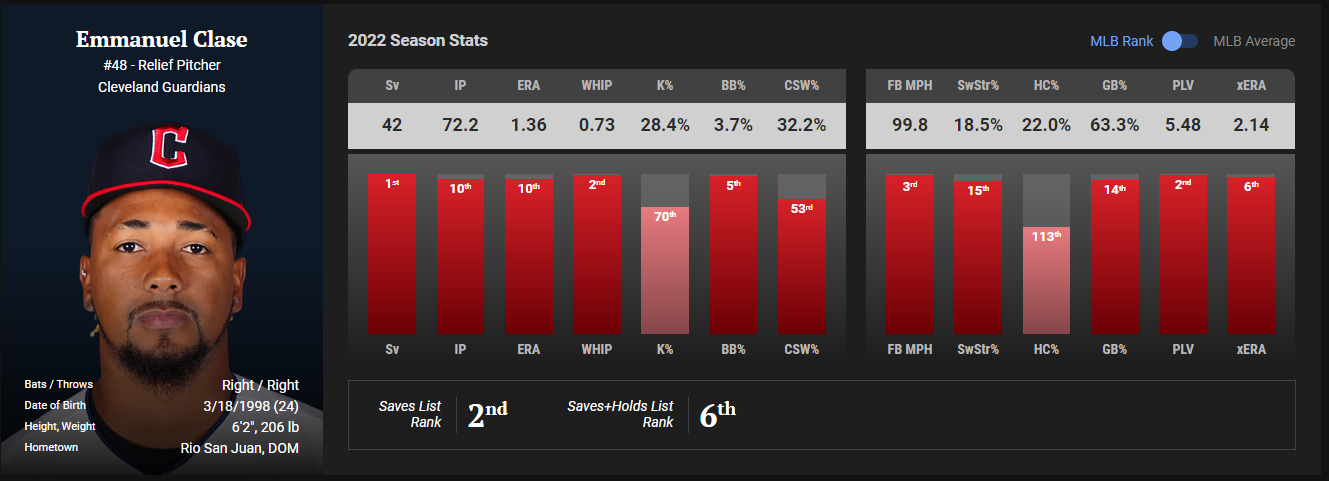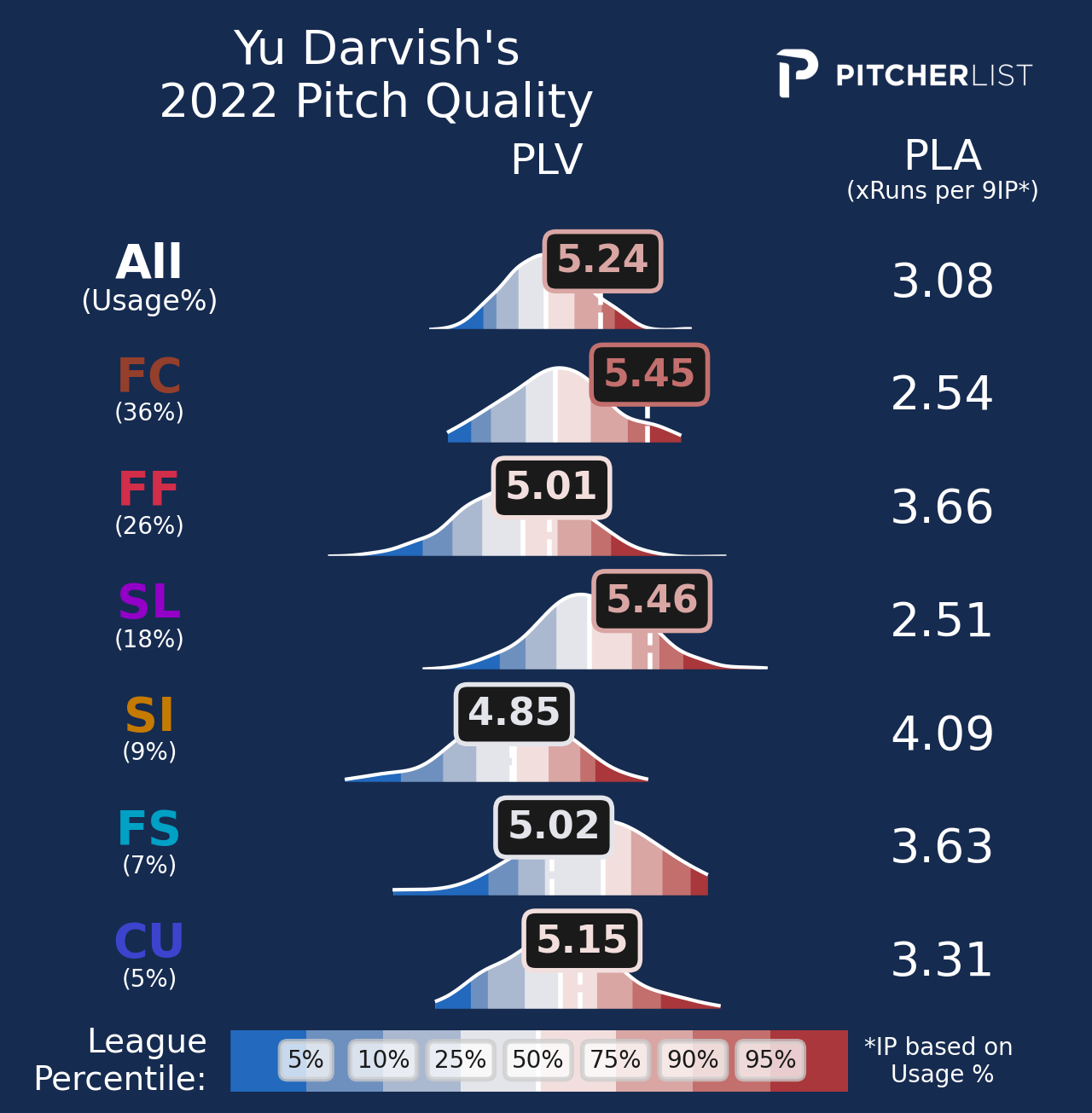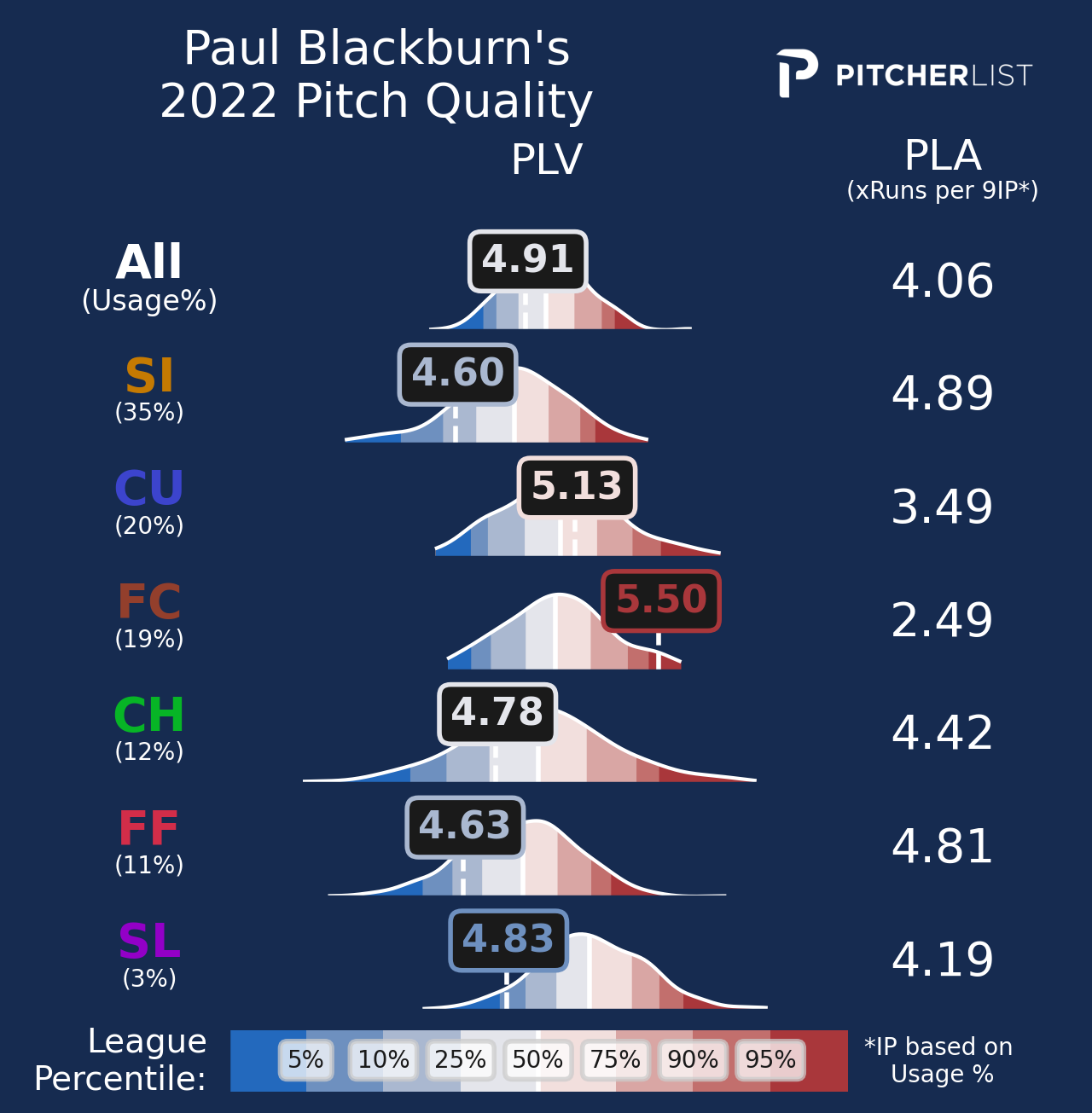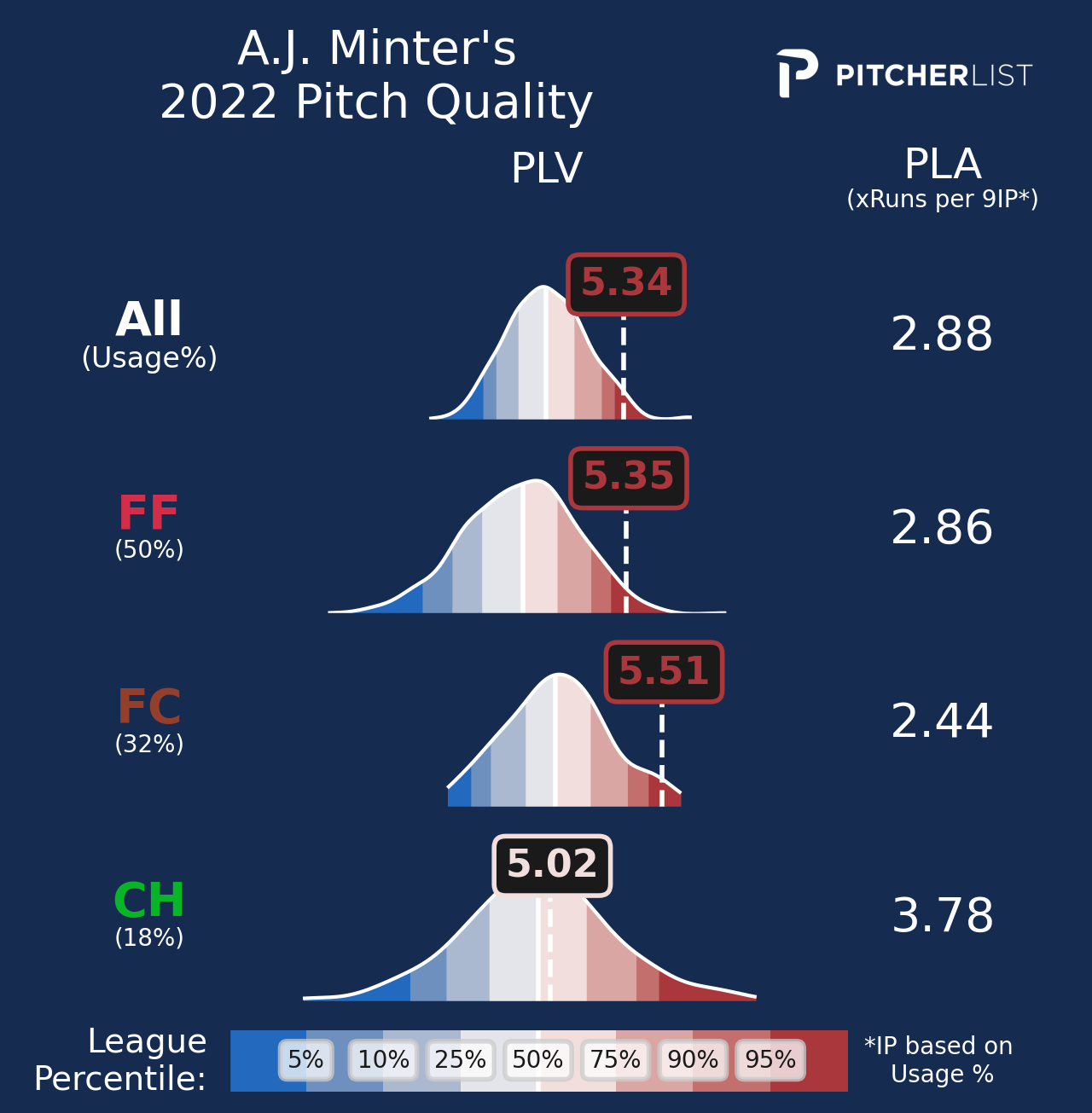What’s up everyone!
I’m in the middle of my annual pitch review series where I’m taking a look at the five best pitches of each pitch type from 2022, as ranked by PLV! Today, we’re going to be looking at the five best cutters from last year.
If you’d like a closer look at what this article series is about, check out the first article in the series on the five best changeups of 2022. Also, check out my other articles in the series:
And if you’d like an in-depth primer on what PLV is and how it works, check it out here.
Otherwise, let’s get to the five best cutters of 2022!
https://gfycat.com/imaginativeshabbyleafwing
José Alvarado had a rock solid year as a late-inning reliever for the Phillies last year, posting a 3.18 ERA with a 1.92 FIP, 37.9% strikeout rate, 22 holds, and two saves through 51 innings and the primary driver behind that success was this cutter.
Alvarado is one of those relievers that essentially throws two pitches: a sinker and a cutter (he also occasionally works in a four-seam fastball, but not often). The sinker is solid, posting a 32.3% chase rate with a .354 wOBA and .341 xwOBA against.
But this cutter, that’s where the money is. Last year, Alvarado’s cutter posted a 45.9% chase rate, 30.3% swinging-strike rate, 36.4% CSW, .128 wOBA against, and a .091 xwOBA against. It’s basically unhittable and even when batters did hit it, they didn’t do much with it, as it also had a 69.2% groundball rate.
Alvarado’s approach was pretty straightforward. He’d locate his sinker early in the count inside to the hitter (regardless of what side of the plate the hitter was on). Then, if he got to two strikes, he’d locate the cutter low and glove-side (so down-and-in to righties) for the strikeout. It’s a simple approach, but it worked great.
https://gfycat.com/quickadoredcanadagoose
As I mentioned in the sliders article, Emmanuel Clase’s stuff is nasty, and his player page here on Pitcher List is ridiculous to look at:

Just pure red from one end of the page to the other. And it’s no surprise, because Clase was awesome last year, posting a 1.36 ERA with a 1.98 FIP and 0.73 WHIP through 72.2 innings.
That slider he has was tied for the best slider in baseball with Jacob deGrom’s slider, and it was tied with deGrom’s slider for the best pitch in all of baseball by PLV.
But we’re here to talk about Clase’s cutter, and while it may not have the highest PLV in baseball, it’s still an absurdly good pitch.
Clase throws the cutter around 60% of the time and it comes in around 99.5 MPH on average. You want some numbers? Here you go: a 43.7% chase rate, a 13.2% swinging-strike rate, a .209 wOBA against, a .248 xwOBA against, and a 66.7% groundball rate, it’s a great pitch. It’s not his go-to strikeout pitch (that’d be the slider), but it still works wonders, and in combination with that slider, it makes Clase one of the most difficult relievers to face in all of baseball.
3. Yu Darvish
https://gfycat.com/lightdensecony
Yu Darvish’s career over the past few years has been quite the rollercoaster. In 2019 with the Cubs, he posts a 3.98 ERA through 31 games. Then, in 2020, he posts a 2.01 ERA through 12 games, followed by a 4.22 ERA in 2021 through 30 games, and then a 3.10 ERA through 30 games last year.
Darvish throws a lot of pitches and tends to mess around with his pitch mix a bit each year. Last year was pretty close to what he worked with in 2021, but he started using his splitter more and threw his slider and curveball a little less.
Either way, Darvish’s repertoire as a whole is pretty solid:

And frankly, that’s pretty impressive given how many different pitches he throws. There isn’t really a stinker in the bunch.
Darvish’s cutter was his primary pitch last year, and it did what you expect a primary fastball-type pitch to do—it got a handful of swings and misses while doing a decent job of inducing weak contact and setting up the rest of his repertoire.
Last year, Darvish threw his cutter 36% of the time, typically locating it low and arm-side as either a front door cutter to righties or a backdoor cutter to lefties, and the pitch posted a respectable .355 wOBa and .340 xwOBA against while also working well as a swing-and-miss pitch, posting a 31.1% chase rate, 12.7% swinging-strike rate, and a 36.4% CSW.
That’s a pretty high CSW, right? Especially for a pitch that wasn’t really a two-strike pitch. Well, if you haven’t put it together yet, that’s because this pitch got watched for a strike pretty frequently, with a 23.7% called strike rate, well above the league average of 14.7% for cutters.
If you followed Darvish’s pattern over the past few years, you might think he’s due for a bad year this year. I think given how solid his repertoire was last year, he’s definitely got a good shot at repeating what he did last year.
https://gfycat.com/insistenttemptingcaimanlizard
Probably not a name you expected to see on this list (or maybe you did, in which case, I’m impressed), Paul Blackburn finally got a full year of starting with the A’s last year and produced less than stellar results. Through 21 starts and 111.1 innings, Blackburn posted a 4.28 ERA with a 4.21 FIP and a 19% strikeout rate.
Not exactly setting the world on fire. But what did work well was this cutter. Last year, Blackburn’s cutter posted a 34.4% chase rate and a 13.7% swinging-strike rate, but he got pretty unlucky with it as well. The pitch had a .444 wOBA against last year, which is very bad, but it also had a .321 xwOBA against, which helps explain the high PLV, since PLV tries to describe the quality of the pitch itself, regardless of the outcomes.
Blackburn actually typically threw this cutter early in at-bats, as he threw it early in the count 70.6% of the time, and only threw it in two-strike counts 12% of the time. His main strikeout pitch was his curveball, which posted a solid 36.4% chase rate and 14.5% swinging-strike rate alongside a .223 wOBA and .230 xwOBA against.
So what’s the issue with Blackburn if it’s not his cutter or curveball? It’s basically everything else:

It’d be interesting to see what might happen if Blackburn ditched the sinker a bit and started using the cutter more because clearly the cutter and curveball work. And there are rumors that Blackburn is experimenting with a new changeup and wants to toy around with his pitch mix, so keep an eye on him this year.
1. A.J. Minter
https://gfycat.com/cleverweepyagouti
A.J. Minter was a dominant reliever last year, posting a 2.06 ERA with a 2.13 FIP and a 34.7% strikeout rate with 34 holds and five saves through 70 innings.
Minter works with three pitches: a fastball, a cutter, and a changeup, and the changeup he doesn’t even throw all that much. But the fastball and cutter? They’re both excellent pitches:

PLV loves it some A.J. Minter, and why wouldn’t it? The fastball posted a .239 wOBA and .246 xwOBA against, not to mention a 32.3% CSW, 30.7% chase rate, and a 15.7% swinging-strike rate, all of which are pretty good numbers for a four-seam fastball.
And then there’s the cutter, which posted a 45.2% chase rate, 21.3% swinging-strike rate, 36.2% CSW, and a .286 xwOBA against (alongside a .357 wOBA, which indicates a bit of bad luck).
Minter was killer last year, and as long as the fastball and cutter are working like they did, he’s likely to be killer again this year.
Graphic adapted by: Chris Corr (@Chris_Studios on Twitter)

